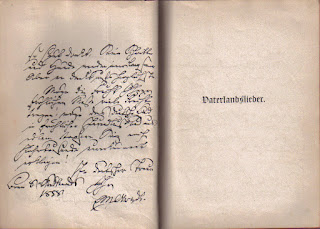In last week's Every picture story I mentioned the songbook that I inherited from my great aunt Esther. I am not sure whether the Hermann Bender who signed it was the confectioner or some eponymous stranger. The confectioner's wife, Henriette Düselmann was Esther's great aunt. (Is there a technical term for my great aunt's great aunt?)
I took photos years ago and must have shared them on my tumblr book blog (deleted by the Inquisition) but forgot to put them here. So here goes (with a fresh photo of the outside of the book):
Note the biernagels (beer nails) - the book is made to be used on drunken nights in unruly taverns, so these metal bumps are there to keep it safe from drink spills. The text on the cover is from a student song and translates as "Let's have fun while we are young." The song is called De brevitate vitae (on the shortness of life) and is entirely in Latin. (Video with text). I thought it was just a quaint old German thing, but Wikipedia tells me it is today widely used as an anthem of educational institutions of all sorts.
It is the 43rd edition of Schauenburgs allgemeines Deutsches Kommersbuch. The excellent Wikipedia entry seems to suggest that it must be from 1891-1893, as these years are documented for the 42nd and the 44th edition, respectively. Wikipedia also lists the multiple subtle changes made to the frontispiece over the years, so here's my version:
the inscription on the left says somebody used it as a guest of the Tueskonia on May 2nd 1896. The closest match I can find is the Tuiskonia in Munich. I'm not clear about the signature, will have another think on that. In any case it could be a nickname. Below it says "Pension Grenzland" - today there is a B&B of that name in Bad Brambach, on the Czech border, near Hof, Bavaria. Not very close to Munich though.
And here we have the beautiful signature of Hermann Bender, who may or may not be the confectioner. He also signed in pencil on the dark paper facing the inside of the cover, but that one is hard to see and not as beautiful.
From the Wikipedia entry I also learned just now that these two mostly illegible handwritten pages shown below are not specific to my copy. (It had always confused me that this seems to be dated 1858 while the book was printed much later, it contains references to events in the 1880s.) Turns out the original authors dedicated the first edition to the poet Ernst Moritz Arndt (see the printed text above right and below left), and it's his reply that was included in later editions as a facsimile. So, phew, I don't have to decipher that.





















No comments:
Post a Comment